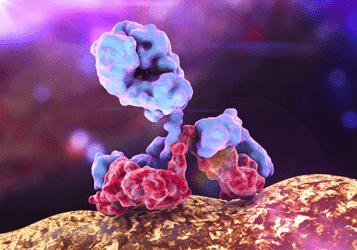- Home
- Products
- Customized ADCs
- FGFR2
- Anti-FGFR2-sulfo-SMCC-DM1 ADC-2
Anti-FGFR2-sulfo-SMCC-DM1 ADC-2 (CAT#: ADC-W-052)
This ADC product is comprised of an anti-FGFR2 monoclonal antibody (clone 12433) conjugated via a sulfo-SMCC linker to DM1. The DM1 is targeted to certain cancers by immunerecognition and delivered into cancer cells via receptor mediated endocytosis. Within the cell, DM1 binds to tubulins, interrupts microtubule dynamics, and subsequently, induces cell death.
- Product Information
- ADC Target
- ADC Antibody
- ADC Linker
- ADC payload drug
- Antibody clone #
- 12433
- Name
- FGFR2
- Alternative Names
- FGFR2; fibroblast growth factor receptor 2; BEK; JWS; BBDS; CEK3; CFD1; ECT1; KGFR; TK14; TK25; BFR-1; CD332; K-SAM; FGFR-2; FGF receptor; soluble FGFR4 variant 4; bacteria-expressed kinase; hydroxyaryl-protein kinase; FGFR2-AHCYL1 fusion kinase protein;
- Target Entrez Gene ID
- 2263
- Target UniProt ID
- P21802
- Overview
- The protein encoded by this gene is a member of the fibroblast growth factor receptor family, where amino acid sequence is highly conserved between members and throughout evolution. FGFR family members differ from one another in their ligand affinities and tissue distribution. A full-length representative protein consists of an extracellular region, composed of three immunoglobulin-like domains, a single hydrophobic membrane-spanning segment and a cytoplasmic tyrosine kinase domain. The extracellular portion of the protein interacts with fibroblast growth factors, setting in motion a cascade of downstream signals, ultimately influencing mitogenesis and differentiation. This particular family member is a high-affinity receptor for acidic, basic and/or keratinocyte growth factor, depending on the isoform. Mutations in this gene are associated with Crouzon syndrome, Pfeiffer syndrome, Craniosynostosis, Apert syndrome, Jackson-Weiss syndrome, Beare-Stevenson cutis gyrata syndrome, Saethre-Chotzen syndrome, and syndromic craniosynostosis. Multiple alternatively spliced transcript variants encoding different isoforms have been noted for this gene.
- Overview
- Human Anti-FGFR2 antibody, clone # 12433
- Clone #
- 12433
- Species Reactivity
- Human
- Name
- sulfo-SMCC (sulfosuccinimidyl 4-(N-maleimidomethyl) cyclohexane-l-carbox late)
- Description
- Noncleavable linkers, is considered noncleavable-meaning linker cleavage, and payload release does not depend on the differential properties between the plasma and some cytoplasmic compartments. Instead, the release of the cytotoxic drug is postulated to occur after internalization of the ADC via antigen-mediated endocytosis and delivery to lysosomal compartment, where the antibody is degraded to the level of amino acids through intracellular proteolytic degradation.
- Name
- DM1 (N2’-Deacetyl-N2’-(3-mercapto-1-oxopropyl)maytansine)
- Description
- Derived from Maytansinoid,a group of cytotoxins structurally similar to rifamycin, geldanamycin, and ansatrienin. The eponymous natural cytotoxic agent maytansine is a 19-member lactam (ansa
macrolide) structure originally isolated from the Ethiopian shrub Maytenus ovatus. Maytansinoids can bind to tubulin at or near the vinblastine-binding site, which interfere the formation of microtubules and depolymerize already formed microtubules, inducing mitotic arrest in the intoxicated cells.
For Research Use Only. NOT FOR CLINICAL USE.
Related Products
- Anti-FOLR1-SPDB-DM4 ADC-5 (CAT#: ADC-W-516)
- Anti-IL9 (Enokizumab)-MC-Vc-PAB-MMAE ADC (CAT#: ADC-W-1451)
- Anti-integrin alpha(v)beta(3) (Etaracizumab)-MC-Vc-PAB-SN38 ADC (CAT#: ADC-W-1500)
- Anti-RSV F (Palivizumab)-MC-Vc-PAB-SN38 ADC (CAT#: ADC-W-2124)
- Anti-PVRL4 (Enfortumab vedotin)-SMCC-DM1 ADC (CAT#: ADC-W-2396)
- Anti-TAG-72 (Satumomab Pendetide)-MC-MMAF ADC (CAT#: ADC-W-2158)
- Anti-CD40 (Dacetuzumab)-MC-Vc-PAB-MMAE ADC (CAT#: ADC-W-899)
- Anti-APP (Crenezumab)-MC-Vc-PAB-DMEA-(PEG2)-duocarmycin SA ADC (CAT#: ADC-W-691)
- Anti-MUC1 (Pemtumomab)-MC-Vc-PAB-DMEA-(PEG2)-duocarmycin SA ADC (CAT#: ADC-W-2431)
- Anti-IL6 (Sirukumab)-MC-Vc-PAB-DMEA-(PEG2)-duocarmycin SA ADC (CAT#: ADC-W-1411)
Published Data
+ Submit Publications

Scientific Resources
Customer Reviews and FAQs
There are currently no Customer reviews or questions for ADC-W-052. Click the button above to contact us or submit your feedback about this product.
Quick Links
Other Products
Same Target
Same Linker
Same Payload
| CAT# | Product Name | Linker | Payload |
| ADC-W-058 | Anti-FGFR2-sulfo-SMCC-DM1 ADC-8 | sulfo-SMCC (sulfosuccinimidyl 4-(N-maleimidomethyl) cyclohexane-l-carbox late) | DM1 (N2’-Deacetyl-N2’-(3-mercapto-1-oxopropyl)maytansine) |
| ADC-W-063 | Anti-FGFR2-sulfo-SMCC-DM1 ADC-13 | sulfo-SMCC (sulfosuccinimidyl 4-(N-maleimidomethyl) cyclohexane-l-carbox late) | DM1 (N2’-Deacetyl-N2’-(3-mercapto-1-oxopropyl)maytansine) |
| ADC-W-061 | Anti-FGFR2-sulfo-SMCC-DM1 ADC-11 | sulfo-SMCC (sulfosuccinimidyl 4-(N-maleimidomethyl) cyclohexane-l-carbox late) | DM1 (N2’-Deacetyl-N2’-(3-mercapto-1-oxopropyl)maytansine) |
| ADC-W-064 | Anti-FGFR2-sulfo-SMCC-DM1 ADC-14 | sulfo-SMCC (sulfosuccinimidyl 4-(N-maleimidomethyl) cyclohexane-l-carbox late) | DM1 (N2’-Deacetyl-N2’-(3-mercapto-1-oxopropyl)maytansine) |
| ADC-W-557 | Anti-FGFR2-MMAE ADC | MMAE (Monomethyl auristatin E) |
| CAT# | Product Name | Linker | Payload |
| ADC-W-054 | Anti-FGFR2-sulfo-SMCC-DM1 ADC-4 | sulfo-SMCC (sulfosuccinimidyl 4-(N-maleimidomethyl) cyclohexane-l-carbox late) | DM1 (N2’-Deacetyl-N2’-(3-mercapto-1-oxopropyl)maytansine) |
| ADC-W-059 | Anti-FGFR2-sulfo-SMCC-DM1 ADC-9 | sulfo-SMCC (sulfosuccinimidyl 4-(N-maleimidomethyl) cyclohexane-l-carbox late) | DM1 (N2’-Deacetyl-N2’-(3-mercapto-1-oxopropyl)maytansine) |
| ADC-W-062 | Anti-FGFR2-sulfo-SMCC-DM1 ADC-12 | sulfo-SMCC (sulfosuccinimidyl 4-(N-maleimidomethyl) cyclohexane-l-carbox late) | DM1 (N2’-Deacetyl-N2’-(3-mercapto-1-oxopropyl)maytansine) |
| ADC-W-208 | Anti-CDH3-sulfo-SMCC-DM1SMe ADC | sulfo-SMCC (sulfosuccinimidyl 4-(N-maleimidomethyl) cyclohexane-l-carbox late) | DM1SMe |
| ADC-W-061 | Anti-FGFR2-sulfo-SMCC-DM1 ADC-11 | sulfo-SMCC (sulfosuccinimidyl 4-(N-maleimidomethyl) cyclohexane-l-carbox late) | DM1 (N2’-Deacetyl-N2’-(3-mercapto-1-oxopropyl)maytansine) |
| CAT# | Product Name | Linker | Payload |
| ADC-W-603 | Anti-FOLH1-SMCC-DM1 ADC-3 | SMCC (N-succinimidyl 4-(Nmaleimidomethyl)cyclohexane-1-carboxylate) | DM1 (N2’-Deacetyl-N2’-(3-mercapto-1-oxopropyl)maytansine) |
| ADC-AA-026 | anti-MIgG(Fc)-N-DM1 ADC | Noncleavable linkers | DM1 (N2’-Deacetyl-N2’-(3-mercapto-1-oxopropyl)maytansine) |
| ADC-AA-031 | anti-MIgG(Fc)Fab-N-DM1 ADC | Noncleavable linkers | DM1 (N2’-Deacetyl-N2’-(3-mercapto-1-oxopropyl)maytansine) |
| ADC-AA-015 | anti-HIgG(Fc)Fab-N-DM1 ADC | Noncleavable linkers | DM1 (N2’-Deacetyl-N2’-(3-mercapto-1-oxopropyl)maytansine) |
| ADC-W-541 | Anti-CD44-DM1 ADC | DM1 (N2’-Deacetyl-N2’-(3-mercapto-1-oxopropyl)maytansine) |
Online Inquiry
Welcome! For price inquiries, please feel free to contact us through the form on the left side. We will get back to you as soon as possible.



